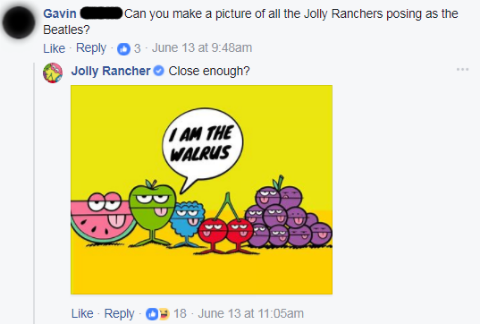It’s safe to say that nobody wants to “suck” at what they do.
Generally, having that verb assigned to your work or operation means change is in order. But Jolly Rancher, a Hershey brand that was experiencing a period of sales decline, decided to put the term — and both its meanings — to good use.
Bill Blubaugh, senior brand director of sweets and refreshments for The Hershey Co., said three years ago, Jolly Rancher, as a hard candy, was “being overlooked” by consumers, especially as chewy candies continued to climb to the top.
“We needed a radical change in how we communicated the brand,” he said in a blog post on Hershey’s site. “We needed to do something innovative, something that could compete in this hyper-competitive set to break the clutter and position Jolly Rancher as a brand that the Millennial generation couldn’t live without — all while being smart, nimble and effective.”
So they kept on sucking. Literally.
In 2015, Hershey and Jolly Rancher, in partnership with collective agency partners Anomaly and Universal McCann, launched the #KeepOnSucking campaign, which focused on presenting the brand as one that young consumers could turn to in “sucky” situations, such as finals week, a trip to the principal’s office, a long ride with parents or seeing an ex on Valentine’s Day.
But “sucking” alone wouldn’t be enough. The brand had to meet young people where they are — on the Internet. Fortunately, the Internet offers many opportunities for users to share and escape from their own stresses, and in some cases, revel in others’ woes.
“Crucially, the Internet serves up a specific tone and style of content — the seemingly senseless nature of cat videos, #fail videos and hilarious memes — that actually make perfect sense in the context of their stressful lives,” Blubaugh said. “Through social listening and behavioral analytics, Jolly Rancher identified nearly every ‘sucky’ conversation and pushed out hyper-contextual and targeted content.”
Hershey and its partners created a posse of fruit characters, known as the Fruit Gang, that failed in all kinds of endeavors for TV spots. Joel Embiid, a rookie Philadelphia 76ers center known for sitting out most of his NBA career due to injury, also got in on the fun, appearing in one of Jolly Rancher’s television ads.
Jolly Rancher also took to social media, posting its own branded content on platforms and responding to mentions of the brand and comments in specific, personalized ways. For example, in June a user named Gavin asked Jolly Rancher to pose the Fruit Gang to resemble The Beatles. So Jolly Rancher did.
 “We lived an ‘always-on’ mindset with thousands of executions,” Blubaugh said. “It was the only way to comment on (nearly) every ‘sucky’ moment in life.”
“We lived an ‘always-on’ mindset with thousands of executions,” Blubaugh said. “It was the only way to comment on (nearly) every ‘sucky’ moment in life.”It worked. In the first 11 months of the campaign, Jolly Rancher’s sales grew by 10 percent. And the brand pulled in $124.36 million over the 52 weeks ending Aug. 13, up 21.47 percent from the year before, according to data from Chicago-based research firm IRI.
The campaign also earned Hershey, Jolly Rancher and its partners the 2017 Gold Effie Award in the Media Idea category — the first marketing and communications Effie Hershey had won in more than two decades.
“Our results were fabulous,” Blubaugh said. “I couldn’t be any prouder. The award’s an amazing time to reflect on the hard work.”
The success of this campaign illustrates two important points. Though they can be difficult to pull off, using cheeky or provocative slogans works, particularly if it plays into the mindset of the target audience.
Furthermore, taking an up-to-the-minute, personalized approach to social media and brand-related content — and having the means and resources to do it — builds a pervasiveness that brands will have to adopt to compete in a noisy media environment that’ll only get noisier.
Way to not suck, Jolly Rancher, even if it took sucking to do it.

